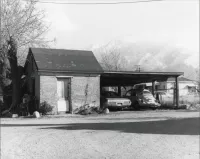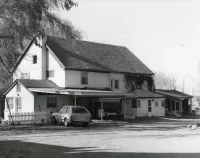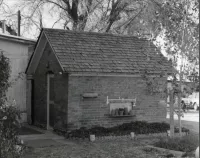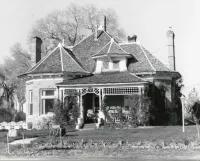Share what you know,
and discover more.
Share what you know,
and discover more.
Feb 14, 1980
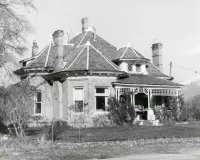
-

- Charmaine Bantugan
National Register of Historic Places - Brinton-Dahl Home
Statement of Significant: The Brinton-Dahl Home is significant as a very well-maintained example of an elaborate example for it' s size and location of a patter n book. Queen Anne influenced residence. The design includes an unusually complex flare d roof form which dominates the front and side facades of the house. I t is one of the most attractive farm houses built in the Big Cottonwood area of the Salt Lake Valley, and one of the few which survives. I t stands on a rise above the surrounding area. / Brick cellar and milk house are included in the site. History of early residents: The Brinton-Dahl Home was constructed in 1885 as a two-family residence for Caleb Dilworth Brinton and his younger brother, David Branson Brinton. David's rapidly expanding family occupied the larger west side, while Dilworth and his wife, the former Emily Elizabeth Maxfield, who were childless, live d in the smaller east portion. David soon moved and Dilworth live d in the house until 1904. Caleb Dilworth Brinton was born in Savannah, Andrew Co. Missouri on November 21, 1848, on route to Utah. His accomplishments include exploring southeastern Utah for colonization, hauling stone for the Salt Lake Temple and construction work. He stated, "There is nothing pertaining to the opening up, building and colonization of a new and desolate country in which I have not taken an active part. " He fille d two missions for the Mormon church and worked in the Salt Lake temple. About 1904 a nephew, David Brinton Bagley, remembers going to the house to take his Saturday bath because it "was the only place i n the neighborhood that had running water in the house". However, of greater significance than the prominent Brinton family was the Mormon pioneer family of Alexander Dahl who bought the Dilworth Brinton farm in 1904. Alexander Dahl was born August 11, 1831, in Frederikstad, Norway. He and his brother. Christian, joined the Mormon church and immigrated to America in 1854. Christian died on the way to Utah, but Alexander arrived in Salt Lake City on September 27, 1855. In. 1857 he served with Lot Smith in Echo Canyon during the Utah War. After his release he walked over 200 miles to Spanish Fork to join a community of Scandinavian Mormons. In Spanish Fork he met sixteen-year-old Ellen Yorgensen. Ellen was born in Lyngby Malmohus, Sweden on March 9, 1842. She arrived in New York City with her family in 1856 after a rough ten-week voyage during which forty-five of the passengers died. The family worked for a short time in New York to earn funds to continue their journey to Utah. In Keokuk, Iowa they contributed their means to assist less fortunate members of the Mormon church to migrate to Utah. Ellen worked as a nurse and a baby sitter, learning the English language from the children for which she cared. k year late r on her trek to Utah she gave her place in the wagon to an expectant mother. Ellen's long career as a midwife began when she assisted the mother in the birth of the child. In 1857 Ellen's family moved to Spanish Fork. Ellen received several offer s to become a plural wife. She refused indignantly. When she met Alexander Dahl, he was so shy that she was sure he would want only one wife. According to reports it took only a little persuasion to convince Alexander to marry her. The Dahls were among the first settler s in East Jordan (Midvale) They started their family in a dug-out, but late r built a large adobe home. Alexander found no employment in his trade as a carpenter so he began buying land and became a dairy s farmer. After forty-five years residence in Midvale, Dahl sold his property to U.S. Steel for the Midvale smelter. They bought a farm and house from Dilworth Brinton in Big Cottonwood where they started a dairy. Alexander Dahl died on February 11, 1911, and Ellen died November 8, 1912. The Dahls were among the first residents of Big Cottonwood to establish a commercial dairy business. They built a large cow barn and milked about fifty cows, at first selling their milk from a cellar near their house and delivering milk to various outlet s in the area. A neighbor, D. Brinton Bagley, reported that in 1905 the great Dahl milk truck with enormous wooden wheels and chain drive was the first automobile he remembers seeing. The milk was cooled in an b adobe trough within the milk house, which still stands, through which ran a constant stream of cold water from one of the farm's three or more flowing wells. About 1911 the Dahl Brothers opened a retail outlet at 478 East 2nd South which advertised "High Grade Milk, Cream, Buttermilk, etc., al l from our own tested cows. Baby Milk a specialty " Later business improved to the point that they bought milk from small producers. The Dahl Brothers were the sons and the daughter of Alexander Dahl.
National Register of Historic Places - Brinton-Dahl Home
Statement of Significant: The Brinton-Dahl Home is significant as a very well-maintained example of an elaborate example for it' s size and location of a patter n book. Queen Anne influenced residence. The design includes an unusually complex flare d roof form which dominates the front and side facades of the house. I t is one of the most attractive farm houses built in the Big Cottonwood area of the Salt Lake Valley, and one of the few which survives. I t stands on a rise above the surrounding area. / Brick cellar and milk house are included in the site. History of early residents: The Brinton-Dahl Home was constructed in 1885 as a two-family residence for Caleb Dilworth Brinton and his younger brother, David Branson Brinton. David's rapidly expanding family occupied the larger west side, while Dilworth and his wife, the former Emily Elizabeth Maxfield, who were childless, live d in the smaller east portion. David soon moved and Dilworth live d in the house until 1904. Caleb Dilworth Brinton was born in Savannah, Andrew Co. Missouri on November 21, 1848, on route to Utah. His accomplishments include exploring southeastern Utah for colonization, hauling stone for the Salt Lake Temple and construction work. He stated, "There is nothing pertaining to the opening up, building and colonization of a new and desolate country in which I have not taken an active part. " He fille d two missions for the Mormon church and worked in the Salt Lake temple. About 1904 a nephew, David Brinton Bagley, remembers going to the house to take his Saturday bath because it "was the only place i n the neighborhood that had running water in the house". However, of greater significance than the prominent Brinton family was the Mormon pioneer family of Alexander Dahl who bought the Dilworth Brinton farm in 1904. Alexander Dahl was born August 11, 1831, in Frederikstad, Norway. He and his brother. Christian, joined the Mormon church and immigrated to America in 1854. Christian died on the way to Utah, but Alexander arrived in Salt Lake City on September 27, 1855. In. 1857 he served with Lot Smith in Echo Canyon during the Utah War. After his release he walked over 200 miles to Spanish Fork to join a community of Scandinavian Mormons. In Spanish Fork he met sixteen-year-old Ellen Yorgensen. Ellen was born in Lyngby Malmohus, Sweden on March 9, 1842. She arrived in New York City with her family in 1856 after a rough ten-week voyage during which forty-five of the passengers died. The family worked for a short time in New York to earn funds to continue their journey to Utah. In Keokuk, Iowa they contributed their means to assist less fortunate members of the Mormon church to migrate to Utah. Ellen worked as a nurse and a baby sitter, learning the English language from the children for which she cared. k year late r on her trek to Utah she gave her place in the wagon to an expectant mother. Ellen's long career as a midwife began when she assisted the mother in the birth of the child. In 1857 Ellen's family moved to Spanish Fork. Ellen received several offer s to become a plural wife. She refused indignantly. When she met Alexander Dahl, he was so shy that she was sure he would want only one wife. According to reports it took only a little persuasion to convince Alexander to marry her. The Dahls were among the first settler s in East Jordan (Midvale) They started their family in a dug-out, but late r built a large adobe home. Alexander found no employment in his trade as a carpenter so he began buying land and became a dairy s farmer. After forty-five years residence in Midvale, Dahl sold his property to U.S. Steel for the Midvale smelter. They bought a farm and house from Dilworth Brinton in Big Cottonwood where they started a dairy. Alexander Dahl died on February 11, 1911, and Ellen died November 8, 1912. The Dahls were among the first residents of Big Cottonwood to establish a commercial dairy business. They built a large cow barn and milked about fifty cows, at first selling their milk from a cellar near their house and delivering milk to various outlet s in the area. A neighbor, D. Brinton Bagley, reported that in 1905 the great Dahl milk truck with enormous wooden wheels and chain drive was the first automobile he remembers seeing. The milk was cooled in an b adobe trough within the milk house, which still stands, through which ran a constant stream of cold water from one of the farm's three or more flowing wells. About 1911 the Dahl Brothers opened a retail outlet at 478 East 2nd South which advertised "High Grade Milk, Cream, Buttermilk, etc., al l from our own tested cows. Baby Milk a specialty " Later business improved to the point that they bought milk from small producers. The Dahl Brothers were the sons and the daughter of Alexander Dahl.
Feb 14, 1980
National Register of Historic Places - Brinton-Dahl Home
Statement of Significant:The Brinton-Dahl Home is significant as a very well-maintained example of an elaborate example for it' s size and location of a patter n book. Queen Anne influenced residence. The design includes an unusually complex flare d roof form which dominates the front and side facades of the house. I t is one of the most attractive farm houses built in the Big Cottonwood area of the Salt Lake Valley, and one of the few which survives. I t stands on a rise above the surrounding area. / Brick cellar and milk house are included in the site.
History of early residents:
The Brinton-Dahl Home was constructed in 1885 as a two-family residence for Caleb Dilworth Brinton and his younger brother, David Branson Brinton. David's rapidly expanding family occupied the larger west side, while Dilworth and his wife, the former Emily Elizabeth Maxfield, who were childless, live d in the smaller east portion. David soon moved and Dilworth live d in the house until 1904.
Caleb Dilworth Brinton was born in Savannah, Andrew Co. Missouri on November 21, 1848, on route to Utah. His accomplishments include exploring southeastern Utah for colonization, hauling stone for the Salt Lake Temple and construction work. He stated, "There is nothing pertaining to the opening up, building and colonization of a new and desolate country in which I have not taken an active part. " He fille d two missions for the Mormon church and worked in the Salt Lake temple. About 1904 a nephew, David Brinton Bagley, remembers going to the house to take his Saturday bath because it "was the only place i n the neighborhood that had running water in the house".
However, of greater significance than the prominent Brinton family was the Mormon pioneer family of Alexander Dahl who bought the Dilworth Brinton farm in 1904. Alexander Dahl was born August 11, 1831, in Frederikstad, Norway. He and his brother. Christian, joined the Mormon church and immigrated to America in 1854. Christian died on the way to Utah, but Alexander arrived in Salt Lake City on September 27, 1855. In. 1857 he served with Lot Smith in Echo Canyon during the Utah War. After his release he walked over 200 miles to Spanish Fork to join a community of Scandinavian Mormons. In Spanish Fork he met sixteen-year-old Ellen Yorgensen.
Ellen was born in Lyngby Malmohus, Sweden on March 9, 1842. She arrived in New York City with her family in 1856 after a rough ten-week voyage during which forty-five of the passengers died. The family worked for a short time in New York to earn funds to continue their journey to Utah. In Keokuk, Iowa they contributed their means to assist less fortunate members of the Mormon church to migrate to Utah. Ellen worked as a nurse and a baby sitter, learning the English language from the children for which she cared. k year late r on her trek to Utah she gave her place in the wagon to an expectant mother. Ellen's long career as a midwife began when she assisted the mother in the birth of the child.
In 1857 Ellen's family moved to Spanish Fork. Ellen received several offer s to become a plural wife. She refused indignantly. When she met Alexander Dahl, he was so shy that she was sure he would want only one wife. According to reports it took only a little persuasion to convince Alexander to marry her.
The Dahls were among the first settler s in East Jordan (Midvale) They started their family in a dug-out, but late r built a large adobe home. Alexander found no employment in his trade as a carpenter so he began buying land and became a dairy s farmer. After forty-five years residence in Midvale, Dahl sold his property to U.S. Steel for the Midvale smelter. They bought a farm and house from Dilworth Brinton in Big Cottonwood where they started a dairy.
Alexander Dahl died on February 11, 1911, and Ellen died November 8, 1912. The Dahls were among the first residents of Big Cottonwood to establish a commercial dairy business. They built a large cow barn and milked about fifty cows, at first selling their milk from a cellar near their house and delivering milk to various outlet s in the area. A neighbor, D. Brinton Bagley, reported that in 1905 the great Dahl milk truck with enormous wooden wheels and chain drive was the first automobile he remembers seeing. The milk was cooled in an b adobe trough within the milk house, which still stands, through which ran a constant stream of cold water from one of the farm's three or more flowing wells. About 1911 the Dahl Brothers opened a retail outlet at 478 East 2nd South which advertised "High Grade Milk, Cream, Buttermilk, etc., al l from our own tested cows. Baby Milk a specialty " Later business improved to the point that they bought milk from small producers. The Dahl Brothers were the sons and the daughter of Alexander Dahl.
Posted Date
Jun 20, 2023
Historical Record Date
Feb 14, 1980
Source Name
National Register of Historic Places
Source Website
Delete Story
Are you sure you want to delete this story?


